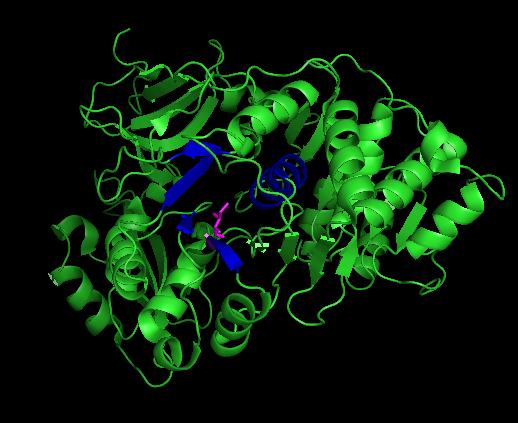Sandbox 167
From Proteopedia
(→Structure) |
(→Related Links) |
||
| (3 intermediate revisions not shown.) | |||
| Line 7: | Line 7: | ||
== Structure == | == Structure == | ||
| - | + | Generally, firefly luciferases have some similarities with Acyl-CoA ligases and some peptide synthetases despite having different cellular effects. In fixing the structure of L. cruciata luciferase, the analog of a potent aminoacyl-tRNA synthetases (DLSA) was successfuly utilized to represent a stable oxyluciferin intermediate.<ref name="structure">PMID:16541080 </ref>. | |
| - | The active site | + | The DLSA occupied the active site of the luciferase, which is composed of an α-helix (residues 248-260) and four short β-sheets (residues 286-289, 313-316, 339-342 and 351-353. Ile288 has been implicated as an important residue in determining the hydrophobicity of the active site environment, and through orientation of the product oxyluciferin, the bioluminescent colour. <ref name="structure" />. |
| - | + | ||
| - | + | ||
| - | + | ||
| - | + | ||
| - | + | ||
| - | + | ||
| - | + | ||
| - | + | ||
| - | + | ||
| - | + | ||
| - | + | ||
| - | + | ||
| - | + | ||
| - | + | ||
| - | + | ||
| - | + | ||
| + | [[Image:2d1s active site with ILE288.jpg | thumb |none | upright=3.0 | Figure 1: PYMOL image of 2D1S highlighting active site and Ile288, putatively identified in hydrophobic control of bioluminescent colour.]] | ||
== Related Links == | == Related Links == | ||
[http://www.pymol.org/ Pymol molecular viewer] | [http://www.pymol.org/ Pymol molecular viewer] | ||
| - | [http://www.pdb.org/pdb/explore/explore.do?structureId= | + | [http://www.pdb.org/pdb/explore/explore.do?structureId=2D1S Protein Data Bank file on 2D1S] |
| - | [http://www.ncbi.nlm.nih.gov/protein/ | + | [http://www.ncbi.nlm.nih.gov/protein/CAA59282.1 NCBI protein entry on ''Photinus pyralis'' luciferase, the american firefly] |
== References == | == References == | ||
<references /> | <references /> | ||
Current revision
| |||||||||
| 2d1s, resolution 1.30Å () | |||||||||
|---|---|---|---|---|---|---|---|---|---|
| Ligands: | , | ||||||||
| Non-Standard Residues: | |||||||||
| Activity: | Photinus-luciferin 4-monooxygenase (ATP-hydrolyzing), with EC number 1.13.12.7 | ||||||||
| Related: | 2d1r, 2d1t | ||||||||
| |||||||||
| |||||||||
| Resources: | FirstGlance, OCA, PDBsum, RCSB, TOPSAN | ||||||||
| Coordinates: | save as pdb, mmCIF, xml | ||||||||
Contents |
Introduction
Bioluminescence is utilized by several nocturnal japanese firely species during mate selection, with males and females illuminating equally. Several common signals appear to be used to communicate everything from "male awaiting a mate" to "female here". [1] While the reaction is quite similiar to that of other bioluminescent luciferases, firefly luciferase has a unique structure in both the protein and luciferin required to produce the bioluminescence. In research, the firefly luciferase from Luciola cruciata is one of many commonly utilized for such purposes as such as sensing cellular ATP levels or visualizing the effects of a promoter sequence, among several others.
Structure
Generally, firefly luciferases have some similarities with Acyl-CoA ligases and some peptide synthetases despite having different cellular effects. In fixing the structure of L. cruciata luciferase, the analog of a potent aminoacyl-tRNA synthetases (DLSA) was successfuly utilized to represent a stable oxyluciferin intermediate.[2]. The DLSA occupied the active site of the luciferase, which is composed of an α-helix (residues 248-260) and four short β-sheets (residues 286-289, 313-316, 339-342 and 351-353. Ile288 has been implicated as an important residue in determining the hydrophobicity of the active site environment, and through orientation of the product oxyluciferin, the bioluminescent colour. [2].
Related Links
Protein Data Bank file on 2D1S
NCBI protein entry on Photinus pyralis luciferase, the american firefly
References
- ↑ Suzuki H, Sato Y, Fujiyama S, Ohba N. Biochemical systematics of Japanese fireflies of the subfamily Luciolinae and their flash communication systems. Biochem Genet. 1996 Jun;34(5-6):191-200. PMID:8813052
- ↑ 2.0 2.1 Nakatsu T, Ichiyama S, Hiratake J, Saldanha A, Kobashi N, Sakata K, Kato H. Structural basis for the spectral difference in luciferase bioluminescence. Nature. 2006 Mar 16;440(7082):372-6. PMID:16541080 doi:10.1038/nature04542


